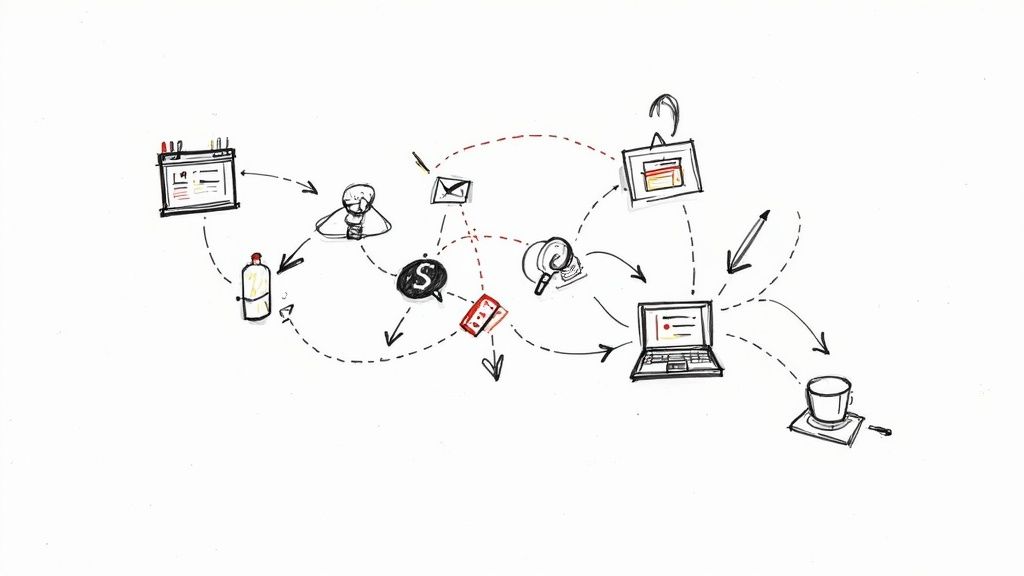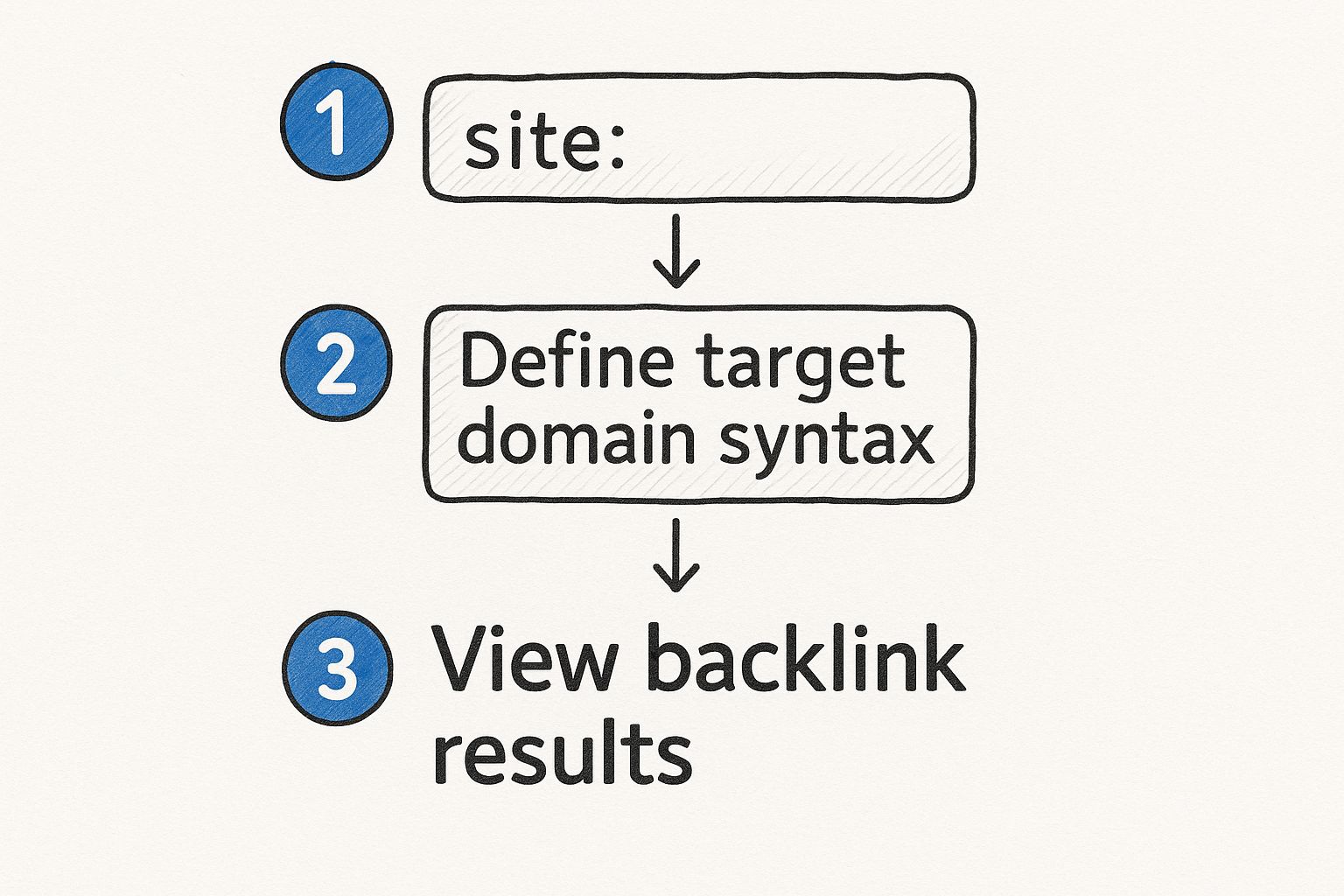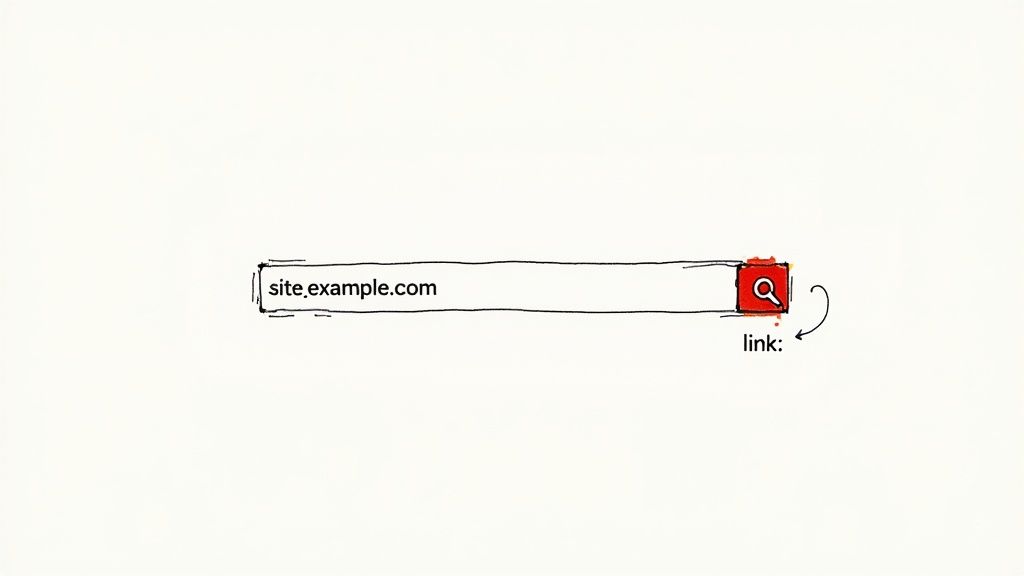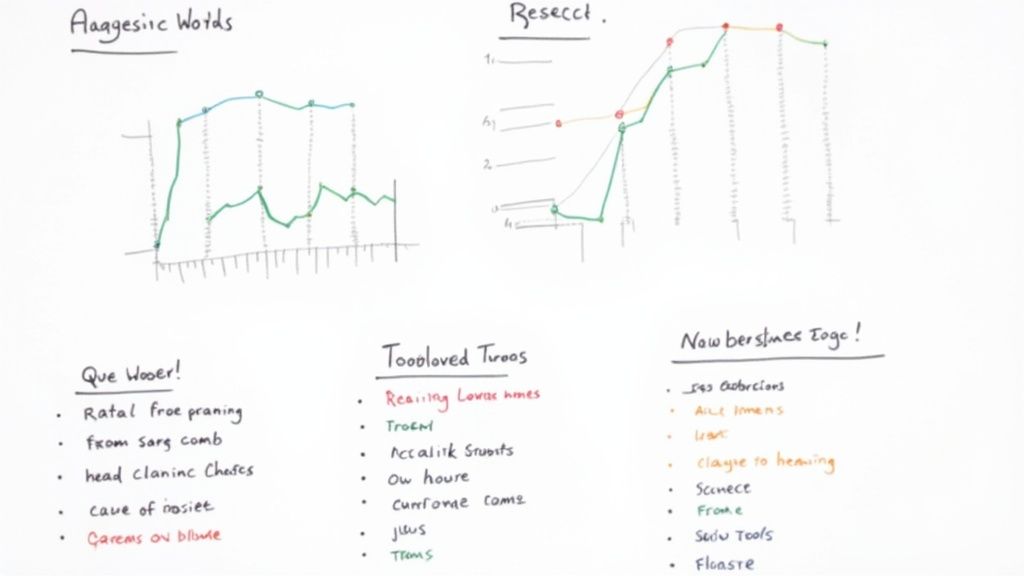How to Find Backlinks on Google Uncovered

Maxime Dupré
9/30/2025

So, you want to find backlinks using Google? The quickest way is with an advanced search operator. Just pop intext:"yourdomain.com" -site:"yourdomain.com" into the search bar to find mentions of your site across the web. For an official list, Google Search Console has a dedicated "Links" report that shows you every site Google knows is linking to you.
Why Backlinks Still Dominate SEO Strategy

Before we jump into the "how," it’s important to get a handle on the "why." Why is this skill so critical? In the constantly changing game of SEO, backlinks are one of the few things that have remained a powerful, consistent signal of authority.
Think of them as digital endorsements. When a reputable website links to your content, it’s basically telling Google, "Hey, this stuff is legit and trustworthy."
This idea has been at the heart of Google from the very beginning, tracing all the way back to the original PageRank algorithm. PageRank was founded on a simple premise: a page's importance could be gauged by the quality and quantity of links pointing its way. While Google's algorithm is a whole different beast today, that core principle hasn't changed.
The Bedrock of Digital Authority
A solid backlink profile is your ticket to the top. It tells Google that your website is a credible source, which is a massive factor in your ability to rank for the keywords that matter.
Without these external "votes of confidence," even the most perfectly crafted content can get lost in the noise. This is why finding and analyzing backlinks isn't just a technical task—it's a strategic imperative.
By digging into who links to your competition, you can get a serious edge. You can:
- Pinpoint their most valuable, link-worthy content.
- Uncover link-building opportunities you didn't know existed.
- Get a clear picture of the tactics winning in your niche.
Backlinks have consistently been one of the top three ranking signals Google uses to determine a webpage's authority and relevance. For a deeper dive, check out this analysis on the importance of backlinks from Rankability.
It's More Than Just a Number
In the end, hunting for backlinks isn't just about compiling a spreadsheet of URLs. It's about reverse-engineering what works and building a solid foundation for long-term organic growth.
When you master this skill, you're essentially creating a roadmap. Every link you find is a clue, showing you what your audience really values and how your competitors are grabbing their attention. This is how you build outreach and content strategies that earn trust from both people and search engines.
Uncover Links with Google Search Operators
You don't always need a pricey subscription to a fancy SEO tool to start digging into a backlink profile. Believe it or not, the most powerful tool for the job is probably the one you already have open in another tab: Google itself. By learning a few specific commands, or "search operators," you can turn a simple search bar into a surprisingly sharp backlink analysis machine.
For years, many of us in the SEO world relied on the old link: operator, but Google has since put that one out to pasture. It’s officially deprecated and just not reliable anymore. The real trick today is getting creative with your search queries to find brand mentions, sniff out new opportunities, and see exactly who is linking to your competition. It's less about formulas and more about thinking like a detective.
Finding Unlinked Brand Mentions
One of the quickest wins in link building is finding websites that have already mentioned a competitor but forgot to add a link. These are practically begging to be turned into backlinks because they're already talking about the brand.
You can uncover these low-hanging fruit with a simple command. Let’s say your competitor is the email marketing platform Mailchimp. You could run a search like this:
intext:"Mailchimp" -site:mailchimp.com
This search tells Google to find any page with the exact phrase "Mailchimp" on it, but—and this is the important part—it excludes any results from Mailchimp's own website. The result is a clean list of third-party articles and reviews mentioning your competitor, many of which won't have a link. That's your outreach list right there.
Pro Tip: Go a step further by searching for mentions in page titles with
intitle:"Competitor Brand". This often surfaces dedicated reviews or feature articles, which are prime targets for a friendly outreach email suggesting they add a link.
Powerful Search Operators for Backlink Discovery
Here’s a quick-reference table of the most effective search operators you can use to find backlink opportunities directly in Google.
| Search Operator | Example Usage | What It Helps You Find |
|---|---|---|
| intext: | intext:"best project management tools" |
Pages containing an exact phrase anywhere in the body text. |
| intitle: | intitle:"SEO strategy" |
Pages with a specific phrase in their title tag. Great for finding focused content. |
| inurl: | "fitness" inurl:resources |
Pages that have a specific word or phrase in their URL, like "resources" or "links". |
| -site: | "competitor name" -site:competitor.com |
Excludes all results from a specific domain. Essential for finding third-party mentions. |
| " " | "digital marketing trends 2024" |
Finds results that contain the exact phrase inside the quotation marks. |
| + | guest post + "your industry" |
Ensures that a specific word is included in the search results. |
Mastering these operators lets you slice and dice Google's index to find exactly what you're looking for, whether it's a resource page or an unlinked mention.
Discovering Link-Building Goldmines
Beyond tracking down brand mentions, you can use these same search operators to find classic link-building opportunities, like resource pages or sites that accept guest posts. These are pages literally built to link out to other websites.
Here are a few of my go-to queries to get you started:
- Find resource pages: Try searching for
"your keyword" + "resource page"or"your keyword" + inurl:links. This is a direct line to curated lists where your content could be a perfect addition. - Hunt for guest post spots: A simple
"your industry" + "write for us"or"your topic" + "contribute an article"search will uncover sites actively looking for new writers. - Identify listicles: Searching
"best tools for" + "your niche"will pull up popular list-style articles. If your competitor is on that list, you've got a great reason to reach out and ask to be included.
This manual approach is all about structuring simple commands to filter through billions of web pages and get a targeted list of potential backlink sources.

By getting comfortable with just a handful of these operators, you can turn Google from a simple search engine into a powerful, free research tool. You can quickly build a solid list of competitor links and outreach targets without spending a dime, giving you a ground-level view that automated tools sometimes miss.
Master Your Own Links with Google Search Console
When it comes to snooping on your competitors, Google's search operators are great. But for getting the real story on your own website, your first and last stop should be Google Search Console (GSC).
This isn't an estimate or a partial sample from a third-party tool. GSC gives you the official data, straight from the source, on how Google actually sees your backlink profile. If you want the ground truth, this is it.
You'll often notice that the backlink count in GSC looks different from what you see in Ahrefs or Semrush. That’s totally normal. Those tools run their own web crawlers, but GSC shows you the links Google has actually found and considers important enough to count. This makes it an absolutely essential tool for understanding your site's SEO foundation.
Navigating the Links Report
Once you're logged into your GSC dashboard, look for the "Links" report in the left-hand sidebar. Think of this as your command center for everything link-related.
It splits your data into two main buckets: External links and Internal links. For finding backlinks from other sites, you'll be living in the External links section.
This area gives you a fantastic high-level overview, breaking things down into:
- Top linked pages: These are the MVPs of your site—the pages racking up the most backlinks.
- Top linking sites: A list of the external domains that link to you the most.
- Top linking text: Shows the most common anchor text people use when linking to your content.
This is where raw data starts to look like a real strategy.
The GSC Links report provides a clean snapshot of which sites are sending the most links your way.

From here, you can click into the "Top linking sites" report and export the whole list. This lets you pull all the domains linking to your site for a much deeper dive.
Turning Data into Actionable Insights
Okay, so you have the data. Now what? The real magic of GSC is in the analysis. By digging into these reports, you can uncover some incredibly powerful trends and opportunities just waiting to be found.
Start with your "Top linked pages" report. Take a close look. Are your most popular pages blog posts? Product pages? Maybe it's that original research you published last year? This report tells you exactly what kind of content acts as a link magnet for your brand.
If you spot a pattern—like your case studies are consistently pulling in great links—that's a huge green light from the universe telling you to create more of them.
Key Takeaway: The "Top linked pages" report isn't just for show. It's a data-backed roadmap for your content strategy, revealing exactly what other people in your space find valuable enough to link to.
On the flip side, the "Top linking sites" report can be your early-warning system. If you suddenly see a bunch of new links popping up from spammy, low-quality, or completely irrelevant websites, that's a major red flag.
These sketchy links could be hurting your rankings, and GSC is often the first place they'll show up. Spotting them here gives you a chance to investigate and, if necessary, disavow them before they do any real damage. To get even more out of this free tool, check out this guide on how to use Google Search Console effectively.
Decode Your Competitor's Backlink Strategy
Getting a list of your competitor’s links is just the first step. The real magic happens when you start analyzing that data to figure out the *story* behind their rankings. This is where you go from having a simple list of URLs to building an actual roadmap for your own link-building campaigns.You're essentially shifting your focus from who links to them to why they link to them. This is the heart of effective competitor intelligence. Once you spot the patterns, you can reverse-engineer what’s working for them and adapt it for your own site. We dive deeper into this concept in our guide on what is competitor intelligence.
Categorize and Conquer The Links
First things first, you need to bring some order to the chaos. As you sift through the backlinks you’ve uncovered, start grouping them into common types. You don't need fancy software for this; a simple spreadsheet is perfect.
The goal here is to figure out which channels your competitors are relying on. Are most of their links coming from:
- Guest Posts: Spot these by looking for author bios on industry blogs that link back to their site.
- Resource Pages: These are curated lists of helpful articles or tools where your competitor’s content is featured.
- Niche Directories: Think industry-specific directories, not generic ones.
- Podcast Mentions: Check the show notes pages from podcasts where they might have been a guest.
- Press and Media: Links from news outlets or other digital PR efforts.
By tagging each link with a category, a clear picture will start to form. If you see that 70% of their best links are from guest posts, you know exactly where to start your outreach.
Identify Their "Link Magnet" Content
Next, flip your analysis around. Instead of looking at the sites linking to your competitor, look at the pages on their own site that are getting all the attention. This is easily one of the most valuable insights you can get.
Look for trends here. Are their most-linked pages long-form guides? Original research? A free tool? Maybe a collection of case studies? This tells you exactly what kind of content people in your niche find valuable enough to link to.
This analysis is critical. The top-ranking page on Google typically has 3.8 times more backlinks than the pages in positions 2 through 10. Knowing what type of content attracts those game-changing links gives you a huge advantage.
This information should directly feed into your content plan. If a competitor published a salary survey that pulled in 50 high-quality links, that’s a clear signal. Creating a more detailed or updated version could be your ticket to similar success.
Assess Link Quality Not Just Quantity
Finally, remember that not all links are created equal. It's easy to get caught up in the numbers, but link quality is what really drives results. A single link from a highly respected, relevant site is worth far more than a hundred links from low-quality blogs.
As you look at each backlink, ask yourself a few key questions:
- Is the linking website actually relevant to my industry?
- Does this site look trustworthy and reputable?
- Is the link placed naturally within the content, or does it feel forced?
This qualitative check helps you prioritize your own efforts. You want to focus on replicating the high-quality, relevant links—not the spammy ones. After all, building a smart, effective strategy means focusing on what actually works.
Expand Your Toolkit with Free Backlink Checkers

While Google's own tools give you a solid starting point for backlink discovery, a handful of free third-party checkers can add some serious firepower to your analysis.
Think of it this way: Google Search Console is the official record, showing you exactly what the search engine has on file for your site. Free tools are the specialized scanners you bring in to reveal data and context that Google simply doesn't show you.
They often introduce unique metrics that help you quickly size up a link's potential value. For example, many use an authority score—like a Domain Rating or Domain Authority—which acts as a quick snapshot of a linking website's overall SEO strength. This is a game-changer for prioritizing high-value targets without getting bogged down in manual research.
Going Beyond Basic Link Lists
The real magic of these external tools is the competitive intelligence they put at your fingertips. Sure, you can hunt for a competitor’s links with search operators, but a dedicated backlink checker serves this data up in a much cleaner, more actionable way.
With just a few clicks, you can see a competitor's newest links, pinpoint their most powerful pages, and even analyze the exact anchor text they’re attracting. It’s an incredible time-saver that helps you spot patterns in their strategy much faster than you ever could on your own. For a good look at your options, this roundup of the best free backlink checker tools is a great place to start.
Uncovering Creative Link Opportunities
Third-party tools also unlock some really creative tactics for finding backlinks that go beyond the usual methods. One of my favorites is the reverse image search. It's powerful but surprisingly underused.
If a competitor has a popular infographic or some killer product photos, you can use a tool to find every single website where that image appears. This is a brilliant way to uncover sites that used their visuals but forgot to include an attribution link. Often, all it takes is a quick, friendly email to turn that unlinked mention into a valuable backlink.
Even though the direct weight of backlinks has shifted over the years, their strategic importance is as strong as ever. In 2024, they made up about 13% of Google's ranking factors, holding their ground as the third most critical piece of the SEO puzzle. You can dig into more of these ranking factor findings.
By blending Google’s raw data with the advanced features of free checkers, you get a much more complete and actionable picture. The best strategy is to use them together. GSC is your source of truth for your own site, while free tools provide the speed and competitive insights you need to build a smart outreach plan. The platforms you choose can make a big difference, so take a look at our business intelligence tools comparison to see how different options measure up.
Answering Your Top Questions About Finding Backlinks
As you start digging into backlink analysis, you'll inevitably run into a few common questions. I see them pop up all the time. Getting these cleared up early will save you a ton of time and help you sidestep some frequent mistakes.
Think of this process like being a detective. The more you know, the better clues you can follow. Let's tackle the big ones.
Is the link: Search Operator Still a Thing?
This is probably the most common question I get. For years, the link: search operator was the standard way to find backlinks in Google. But the short answer today is no, it's not reliable anymore.
Google officially deprecated it a while back. Sure, you might still see it pull a few random results here and there, but it's just a tiny, incomplete sample. It’s absolutely not something you can count on for a full picture.
You're much better off getting creative with search strings. A query like intext:"yourdomain.com" -site:"yourdomain.com" will give you a far more useful list of mentions across the web—precisely the kind of stuff the old operator would miss.
How Do I Know if a Backlink is Actually Any Good?
Finding a link is just the first step. The real question is, is it a good link? A high-quality backlink has a few tell-tale signs that I always look for.
- It's Topically Relevant: The website linking to you should be in your niche or a closely related one. For example, a link from a popular marketing blog to an SEO tool makes perfect sense. A link from a local pet grooming site? Not so much.
- The Site Has Real Authority: Does the website have its own established audience and consistent traffic? A link from a site with a real, engaged readership carries a lot more weight.
- The Placement Feels Natural: The link shouldn't feel jammed in or out of place. It should flow with the content and genuinely add value for someone reading the page.
My Two Cents: Actively avoid links from spammy sites, paid link farms, or sketchy directories. A single bad link can cause more damage to your SEO efforts than having no link at all.
Why Are My Backlink Numbers Different in Every Tool?
This one trips up a lot of people. You look at Google Search Console and see one number, then you pop over to a tool like Ahrefs and see something completely different. Don't panic—this is totally normal.
Here’s how to think about it: Google Search Console is your source of truth. It shows you the links that Google has actually found and decided are important enough to consider when evaluating your site. It’s the official record.
Third-party tools, on the other hand, run their own massive web crawlers, creating their own private index of the internet. They often discover more links than GSC reports, including brand new ones or links from lower-quality sites that Google might just be ignoring.
My advice? Use GSC to understand your site's "official" backlink profile and lean on third-party tools for deep competitive research.
Trying to keep tabs on every backlink your competitors build or every keyword they start ranking for can feel overwhelming. ChampSignal takes that work off your plate. It automates the monitoring and sends you alerts only when a competitor makes a move that actually matters. You can stop guessing and start making strategic decisions. Explore how ChampSignal can give you a competitive edge.
Get Started
Competitor Monitoring That Doesn't Suck
Spend under two minutes per week monitoring your competitors. Receive only the information that matters.
Join other SMBs on top of their competitors.

